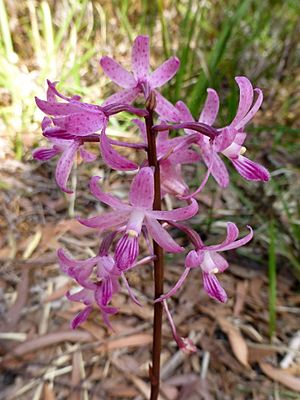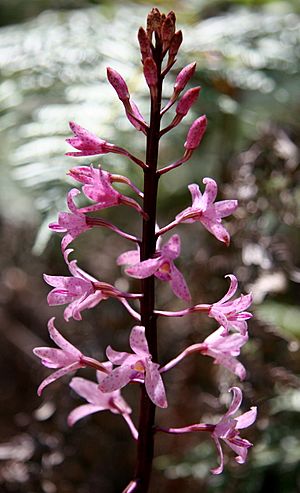Rosy hyacinth-orchid facts for kids
Quick facts for kids Rosy hyacinth orchid |
|
|---|---|
 |
|
| Dipodium roseum in Lake Conjola | |
| Scientific classification | |
| Genus: |
Dipodium
|
| Species: |
roseum
|
The rosy hyacinth orchid (scientific name: Dipodium roseum) is a special type of orchid found in eastern and south-eastern Australia. It is also called the pink hyacinth orchid. This plant is unique because it does not have leaves. Instead, it gets its food from dead plants and fungi in the soil.
In summer, this orchid grows a tall stem with many pale pink flowers. These flowers have small, dark red spots. The rosy hyacinth orchid is very common and can be found in many places. People sometimes confuse it with another orchid called D. punctatum. However, D. roseum has darker flowers with fewer spots.
Contents
What Does the Rosy Hyacinth Orchid Look Like?

The rosy hyacinth orchid is a plant that lives for many years. It does not have leaves. Instead, it has underground tubers, which are like small, round storage organs. This orchid gets its food from fungi in the soil. It is a type of herbaceous plant, meaning it has soft, green stems rather than woody ones.
Each plant grows a tall stem, usually between 40 and 100 centimeters (about 16 to 39 inches) high. This stem can be green or dark reddish-black. On this stem, you can find between 15 and 50 pale pink flowers. Each flower has small, dark red spots and is about 2 to 3 centimeters (about 0.8 to 1.2 inches) wide.
The flowers have parts called sepals and petals. These are long and narrow, about 13 to 20 millimeters (0.5 to 0.8 inches) long. Their tips curve backward. The labellum is a special lip-like part of the flower. It is pink with dark lines and has three parts, with their tips pointing upwards. The middle part of the labellum has a wide band of pink to purple hairs. Sometimes, you can even find a rare white version of this orchid! It usually flowers from November to February.
How to Tell D. roseum Apart from D. punctatum
It can be tricky to tell the rosy hyacinth orchid apart from D. punctatum. But there are a few clues:
- D. roseum has a wider band of hairs on its labellum and has stripes.
- Its spots are smaller.
- The sepals and petals of D. roseum curve backward a lot.
- D. punctatum does not have stripes on its labellum.
- It has much more noticeable spots.
- Its sepals and petals are flat or only slightly curved backward.
How the Rosy Hyacinth Orchid Got Its Name
The scientific name Dipodium roseum was officially given to this orchid in 1991. Two botanists, David Jones and Mark Clements, described it. Their description was published in a research paper called Australian Orchid Research.
The first plant used to describe the species, called the type specimen, was found in Montrose, in Victoria's Dandenong Ranges. The second part of its scientific name, roseum, comes from a Latin word. It means "rose-coloured," which perfectly describes the pink color of its flowers. Before 1991, this orchid was thought to be part of a larger group of Dipodium punctatum orchids.
Where the Rosy Hyacinth Orchid Lives
The rosy hyacinth orchid can grow in many different places. You can find it in dry woodlands and also in very wet forests. It lives in Queensland, south of Gympie, and along the coast and ranges of New South Wales and the Australian Capital Territory. It is also very common in most parts of Australia, where it is the most common type of Dipodium orchid. You can also find it in the south-east of South Australia. It is the only member of its group that grows in Tasmania.
How the Rosy Hyacinth Orchid Reproduces
Like all orchids in the Dipodium group, the rosy hyacinth orchid is pollinated by native bees and wasps. These insects help carry pollen from one flower to another, allowing the orchids to make seeds and reproduce.
Why It's Hard to Grow This Orchid
It is very difficult to grow leafless Dipodium orchids, including the rosy hyacinth orchid, outside of their natural habitat. This is because they need a special connection with tiny fungi in the soil to get their food. Scientists and gardeners have not yet figured out how to perfectly copy this relationship in a garden or greenhouse.
See also
 In Spanish: Dipodium roseum para niños
In Spanish: Dipodium roseum para niños

